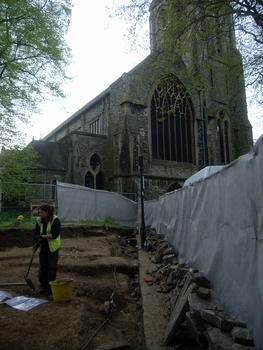Archaeological excavation and watching brief at St Mary's Church, Southampton, Hampshire (SOU1503)
Dave Reay, Lorraine Mepham, J McKinley, Ken Lymer, 2020. https://doi.org/10.5284/1075320. How to cite using this DOI
Data copyright © Wessex Archaeology unless otherwise stated
This work is licensed under a Creative Commons Attribution 4.0 International License.
Primary contact
Wessex Archaeology
Portway House
Old Sarum Park
Salisbury
SP4 6EB
UK
Tel: 01722 326867
Fax: 01722 337562
Resource identifiers
- ADS Collection: 3655
- DOI:https://doi.org/10.5284/1075320
- How to cite using this DOI
Introduction

Wessex Archaeology was commissioned by Stephen Cox Associates to undertake an archaeological excavation and watching brief during works at St Mary’s Church, St Mary Street, Southampton. The works comprised the construction of a new car parking area and access ramp, trenching for new external lighting and CCTV surveillance, and drainage repairs around the perimeter of the church building.
The access ramp for the car park occupied an area of 81 square meters and was excavated by hand to the required formation level after the machine removal of topsoil. In the deeper portion of the ramp flanking the existing road, a considerable number of inhumation burials and several funerary structures were revealed. The remains of 14 in situ burials were investigated, 11 of which were exhumed and reburied within the churchyard. The remainder were not lifted as they were below the formation level within brick-lined graves. Six funerary structures were encountered, four of which were brick-lined graves.
There was a significant quantity of disarticulated human remains present in all excavated deposits on the site, especially in the graveyard soils. This is suggestive of a considerable density of burials, with a substantial amount of reworking and re-cutting of the cemetery soil. This is supported by the partial and truncated nature of a number of the in situ skeletons, and is to be expected in an urban graveyard with a prolonged period of use. Remains of further burials were visible below the formation level of the ramp, within the bases of the excavated graves. It is highly probable that there are considerably more remains within the ramp area below the finished level.
All of the coffined burials appear to have been made in the later half of the 18th and first half of the 19th century. It is possible that some of the graves without coffin furniture are earlier in date.
The assemblage within this area of the cemetery appears to represent a normal, domestic population, with a slightly higher proportion of immature individuals than comparative contemporary populations that have been analysed. The two male skeletons for which stature was estimated were both well above the mean for the period. Whilst caution must be applied to such limited data, this, together with other observations on skeletal morphology and the absence of evidence for childhood stress-related illnesses, suggest the individuals were not living in poverty and did not represent the lowest social strata. They generally appear to have been well nourished, and the large size and robusticity of the male skeletons suggest many of the men were involved in strenuous physical work, perhaps in the dockyards nearby.
The results of the osteoarchaeological analysis, although limited by the small sample size, highlights the high potential of the cemetery population for future analysis should any further work be done within the cemetery.





